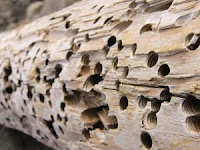Pestec has long been providing termite control in Sydney for 12 years now. All Pestec consultants are licenced to offer termite control and are very highly skilled at delivering an array of preventative termite control measures. Termite control in Sydney features many alternatives as the landscape differs from suburb to suburb so does the soil type and construction methods of houses.
Soil types have a big variation in getting rid of termites as certain
pesticides have really quick life spans in high alkaline soils while
some don't mix immediately to silica (sand). The significantly varying
geography of Sydney has an impact on the place where termites nest and
where they will go. Construction plans of houses in Sydney can make
termite control very difficult. A number of houses are made with hard to
reach voids under them, not only does this allows ideal humid little
entry ways for termites but the termites (and voids) have a risk of not
getting found till the time they result in large harm to the home.
Pestec performs a large number of solutions to houses every year, the actual treatment solution applied depends on what species of termite has been seen infesting the property plus considering the above elements. The main varieties of procedure that are employed in Termite control in Sydney are Baiting, Dusting and chemical soil treatments.
Baiting is a process that is done by putting feeding channels to a location where termites have been found making damage, the termites find the trap more palatable and much easier to take in than hardwood and soon switch to feeding on the bait. The poison in the bait is in very low quantities so the termites don't discover it is there. Termites work in a communal system where food is enjoyed among the entire colony so in time all termites in the colony will be stricken by the bait and the colony fully destructs.
Dusting is a technique of termite colony elimination in which a finely ground insecticidal dust is very carefully introduced to the termite operation by using a hand bulb puffer which enable the dust to be supplied over the workings. When termites encounter the dust they inadvertently bear it through the channels back into the center nesting spot, as the termite travels he is being regularly groomed by other termites who by themselves inadvertently acquire particles of the dust and can affect further termites they come into contact with.. If there is an issue with dusting it is that it can't be utilized successfully unless a number of termites have contact with it. In some cases this will call for the removal of wall linings, floor coverings, etc. to see the numbers of termites required.
Chemical soil treated zones is often a means of helping to guard a home from termite invasion. The primary factor with applying any chemical soil treated zone is that the soil around a building needs to be reachable to facilitate the termiticide to be placed to it. Where there is cement around a house e.g. a footpath or similar, the conventional strategy is to drill openings through the concrete at regular intervals to allow the treatment of the termiticide. This kind of treatment is nice theoretically though in reality there are many challenges . The principal issue is that the applicator cannot really know where the pesticide has sprayed to under the concrete and so whether a continual zone has really been set up.
Typically, baiting and then checking with an in ground termite monitoring system gives the best advantage and are the most recommended options in termite control.
Sources:
Check this site, http://www.pestec.com.au/termite-control - for pest control solutions in Sydney, seek the help of Pestec.


No comments:
Post a Comment